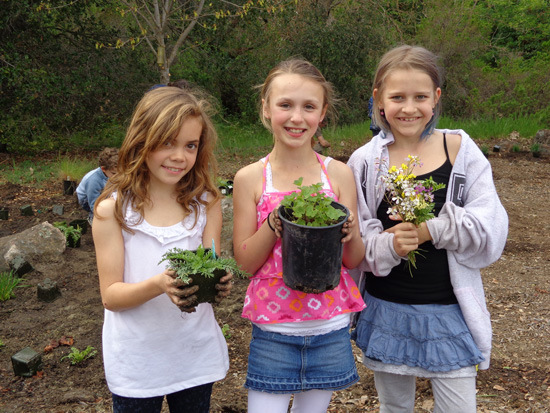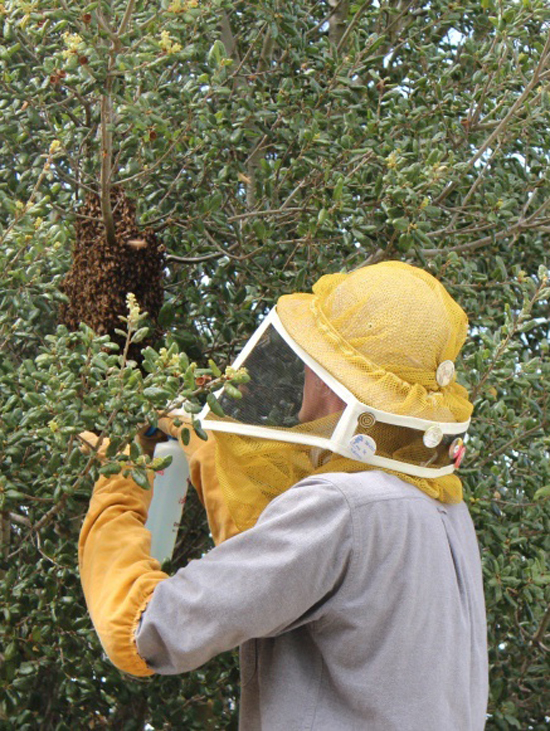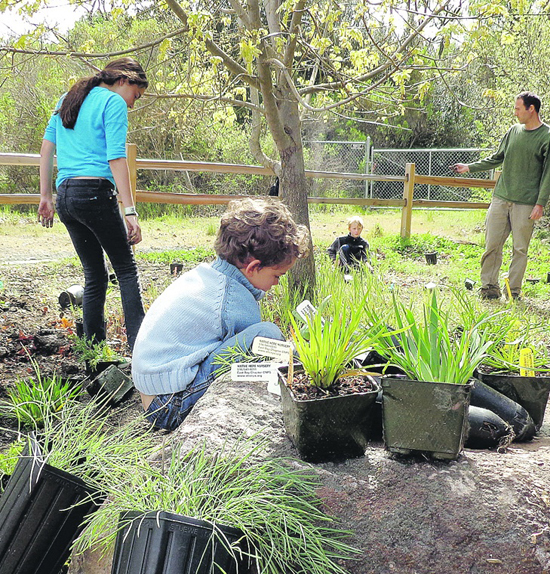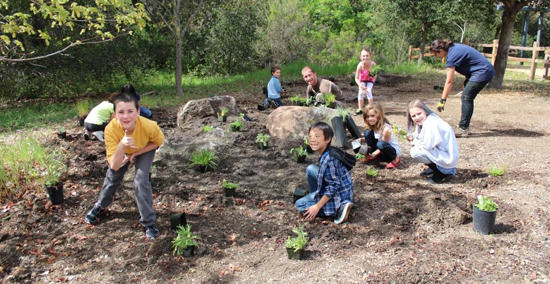 | | | From left, Allie Fink, Alicia Hober and Arlee Farrell help install a variety of native plants for butterflies and Community Park visitors to enjoy.
Photo Cathy Tyson
| | | | | | Cue the bat, or rather bee, signal. Except unlike Batman, Parks and Recreation staff needed a bee hero to save the day. Just a few hours before young helpers from Merriewood Children's Center were slated to walk over to install native plants in a brand new butterfly garden, bees congregated a little too close for comfort. "What are the odds that a swarm of bees would decide to take refuge in an oak tree that is right next to the butterfly garden?" said Parks, Trails and Recreation Director Jennifer Russell just a couple of hours from scheduled planting.
 Although he didn't have a cape or a bat/bee mobile, Lafayette bee guy Steven Harris happened to pick up his phone and was available to come immediately and gently collect the swarm and move it to a more appropriate location. Harris is on a list of volunteers, with the Mount Diablo Beekeepers Association, who remove swarms. Bee swarming is a natural phenomenon; bees leave their home hive because it's getting over-crowded as more nectar and pollen are stored in the hive. "Fat and happy honeybees, with no home to protect, are less likely to sting," advises the Mount Diablo Bee Keepers Association. While pollinating honey bees are generally a very good thing, they may not be a terrific combination with little helpers.
Although he didn't have a cape or a bat/bee mobile, Lafayette bee guy Steven Harris happened to pick up his phone and was available to come immediately and gently collect the swarm and move it to a more appropriate location. Harris is on a list of volunteers, with the Mount Diablo Beekeepers Association, who remove swarms. Bee swarming is a natural phenomenon; bees leave their home hive because it's getting over-crowded as more nectar and pollen are stored in the hive. "Fat and happy honeybees, with no home to protect, are less likely to sting," advises the Mount Diablo Bee Keepers Association. While pollinating honey bees are generally a very good thing, they may not be a terrific combination with little helpers.
 Looking to create a tasty nectar-rich environment Greg Travers, parks maintenance specialist worked with intern Lena Orlando and Merriewood's Kevin Feinstein to come up with the garden project filled with native flowering plants like monkey flower, sage, asters and mugwort that offer lots of tasty treats. Merriewood is an afterschool day care facility associated with Burton Valley Elementary School just over the hill.
Looking to create a tasty nectar-rich environment Greg Travers, parks maintenance specialist worked with intern Lena Orlando and Merriewood's Kevin Feinstein to come up with the garden project filled with native flowering plants like monkey flower, sage, asters and mugwort that offer lots of tasty treats. Merriewood is an afterschool day care facility associated with Burton Valley Elementary School just over the hill.
 Orlando carefully researched types of low maintenance native plants that will attract butterflies and mapped out the best spots for sun- and shade-loving plants that won't need much watering after they're established. She is studying horticulture at Oregon State University; although that's a long commute from Lafayette she takes her full load of classes online and anticipates graduating next summer.
Orlando carefully researched types of low maintenance native plants that will attract butterflies and mapped out the best spots for sun- and shade-loving plants that won't need much watering after they're established. She is studying horticulture at Oregon State University; although that's a long commute from Lafayette she takes her full load of classes online and anticipates graduating next summer.
 Butterflies like to stay warm so three large boulders selected by Orlando, which have a bit of a natural dip in the center to hold water, were placed in the sunny center of the garden to be a natural heater.
Butterflies like to stay warm so three large boulders selected by Orlando, which have a bit of a natural dip in the center to hold water, were placed in the sunny center of the garden to be a natural heater.
 With fresh water in the nearby creek, this particular location just across the footbridge and to the left in the community park is flanked by picnic tables and a play area for little ones; an obvious choice for optimal butterfly viewing. For now though, the hardy native plants need to grow and actually flower to entice with the equivalent of chocolate cake for butterflies. Good thing the transformation from egg to caterpillar to chrysalis to butterfly may take a while.
With fresh water in the nearby creek, this particular location just across the footbridge and to the left in the community park is flanked by picnic tables and a play area for little ones; an obvious choice for optimal butterfly viewing. For now though, the hardy native plants need to grow and actually flower to entice with the equivalent of chocolate cake for butterflies. Good thing the transformation from egg to caterpillar to chrysalis to butterfly may take a while.
 Ambitious bee hero Steven Harris, 23, is happy to collect swarms since he's starting a honey business. A graduate of Acalanes and former student at Cal Poly San Luis Obispo majoring in agriculture and environmental plant sciences, he had taken classes on bee keeping. When not at his part-time jobs at Whole Foods and Diablo Valley Montessori he's busy getting "Bee Friendly Honey" up and running. His five-year plan includes starting a nursery business selling plants that draw honey bees and beneficial insect plants that attract lady bugs and praying mantis that eat bad bugs.
Ambitious bee hero Steven Harris, 23, is happy to collect swarms since he's starting a honey business. A graduate of Acalanes and former student at Cal Poly San Luis Obispo majoring in agriculture and environmental plant sciences, he had taken classes on bee keeping. When not at his part-time jobs at Whole Foods and Diablo Valley Montessori he's busy getting "Bee Friendly Honey" up and running. His five-year plan includes starting a nursery business selling plants that draw honey bees and beneficial insect plants that attract lady bugs and praying mantis that eat bad bugs.

|



